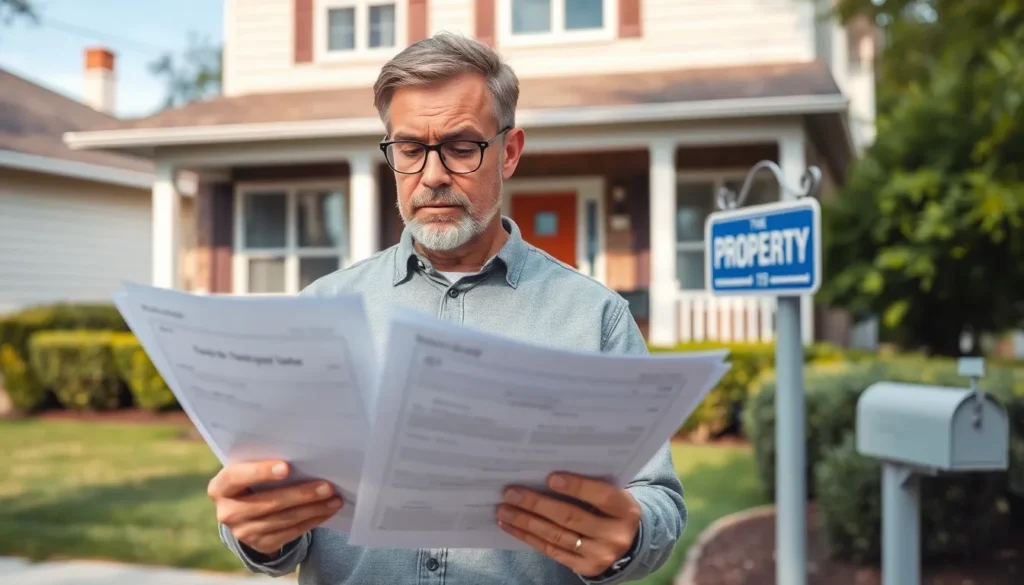Table of Contents
ToggleNavigating the world of housing can feel like deciphering a secret code, especially when it comes to leasing and renting. While both options let you enjoy a cozy space without the commitment of buying, they’re not quite the same. Think of leasing as the long-term relationship—steady, predictable, and possibly involving a shared Netflix account. Renting, on the other hand, is more like a casual fling—flexible with fewer strings attached.
Overview of Leasing and Renting
Leasing and renting represent two distinct methods for occupying properties. Understanding their differences clarifies options available in the housing market.
Definition of Leasing
Leasing involves a long-term contract, typically lasting between one to three years. An occupant agrees to specific terms regarding rent, utilities, and property use. At the lease’s end, tenants generally have the option to renew or purchase the property. Responsibilities often include maintenance and repairs, shared between the landlord and tenant. Fixed monthly payments remain constant throughout the lease duration, providing financial consistency.
Definition of Renting
Renting usually refers to a short-term arrangement, often month-to-month or with leases lasting less than a year. It offers flexibility, allowing tenants to move with relative ease. Payments fluctuate based on rental terms, and tenants face fewer obligations for property upkeep. Landlords typically handle maintenance and repairs. Since renting lacks long-term commitments, it appeals to those seeking short-term housing solutions.
Key Differences Between Leasing and Renting

Understanding the distinctions between leasing and renting helps individuals make informed housing decisions. Each option addresses various needs regarding stability, flexibility, and financial obligations.
Duration of Agreement
Leasing typically involves long-term commitments, often ranging from one to three years. This time frame provides stability for tenants. Renting, however, usually consists of short-term arrangements, often on a month-to-month basis. Such agreements allow renters to adapt quickly to changing circumstances. Individuals seeking a permanent residence might prefer leasing while those needing temporary housing could benefit from renting.
Financial Commitment
Leasing agreements come with fixed monthly payments, simplifying financial planning. Renters, in contrast, may encounter fluctuating costs, which can complicate budgeting. Lease agreements often require an upfront payment or security deposit, acting as a financial assurance for landlords. On the other hand, renting usually necessitates a smaller deposit and allows for lower initial costs, appealing to those with limited financial resources.
Maintenance Responsibilities
Leasing often includes shared responsibilities for maintenance and repairs. Tenants might need to address minor issues while landlords handle significant concerns. Renting tends to place fewer maintenance obligations on renters. Generally, in a rental situation, landlords assume full responsibility for upkeep, allowing renters to focus on their living experience.
Flexibility and Mobility
Flexibility stands as a significant advantage of renting. Tenants can change locations easily without long-term obligations. Leasing, however, requires more commitment, making it less adaptable to sudden life changes. For individuals relocating for work or personal reasons, renting facilitates quick transitions. In contrast, leasing provides security and predictability, appealing to those looking for stability in their housing situation.
Pros and Cons of Leasing
Leasing offers distinct advantages and disadvantages that influence housing choices. Understanding these pros and cons is essential for individuals considering long-term commitments.
Advantages of Leasing
Leasing provides stability through fixed monthly payments, which helps with budgeting. Predictable expenses eliminate surprise costs, making financial planning easier. Individuals enter agreements typically lasting one to three years, securing a home for an extended period. Some leases include maintenance agreements, reducing responsibility for repairs. People often find leasing appealing for its stability, especially those planning to stay in one location for a while.
Disadvantages of Leasing
Leasing involves long-term contracts, which limit flexibility. Individuals may face penalties for breaking a lease, complicating relocation. Upfront costs usually require larger deposits, impacting initial financial commitments. Responsibilities for minor repairs often fall on tenants, adding burdens. Leasing can become restrictive, making it challenging if personal or professional circumstances change unexpectedly.
Pros and Cons of Renting
Renting offers various benefits and drawbacks that influence housing decisions. Understanding these can help individuals choose the best option for their needs.
Advantages of Renting
Flexibility defines renting. Short-term agreements allow renters to move with ease, accommodating changes in jobs or lifestyles. Lower upfront costs also characterize renting, as security deposits and initial fees tend to be smaller compared to leasing. Renters benefit from minimal maintenance responsibilities, since landlords often handle repairs and upkeep. Affordable monthly payments attract many as well, allowing for better financial management without long-term commitments.
Disadvantages of Renting
Stability may pose a challenge with renting. Month-to-month arrangements can lead to fluctuations in rent prices, causing uncertainty for renters. Limited control over property decisions may frustrate tenants, as landlords dictate rules and regulations. Furthermore, renters usually lack the opportunity to build equity, which leasing often provides. Rent increases might occur upon renewal of lease terms, impacting budget planning for individuals. Understanding these drawbacks helps renters weigh their options effectively.
Choosing between leasing and renting ultimately depends on individual needs and circumstances. For those prioritizing stability and predictability leasing offers a structured approach with fixed payments and longer commitments. On the other hand renting caters to those who value flexibility and lower upfront costs allowing for quick adjustments to living situations.
Understanding these differences empowers individuals to make informed decisions that align with their lifestyle and financial goals. Whether one opts for the security of a lease or the adaptability of renting knowing the nuances can lead to a more satisfying housing experience.






